Five-seveN pistol chambered for 5,7x28
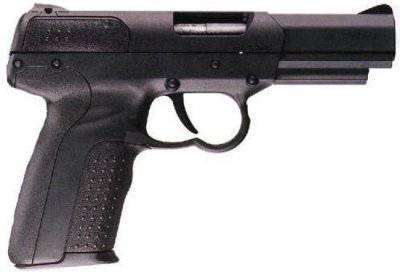 This sample of the pistol appeared as an addition to the P90 submachine gun, so that we can speak about the cartridge-weapon complex, and not about a single copy. Considering that the submachine gun itself came out quite unusual, many expect that the pistol will also represent a not entirely classical design, but this is absolutely not the case. Although if you look at the weapon carefully, you can see that many moments in it are really interesting and deserve, if not praise, then at least attention, but in general, nothing supernova in the weapon has been applied. The pistol was developed at the end of the 80s of the last century, but its production was established only in the 1998 year. It was then that the first version of this weapon appeared.
This sample of the pistol appeared as an addition to the P90 submachine gun, so that we can speak about the cartridge-weapon complex, and not about a single copy. Considering that the submachine gun itself came out quite unusual, many expect that the pistol will also represent a not entirely classical design, but this is absolutely not the case. Although if you look at the weapon carefully, you can see that many moments in it are really interesting and deserve, if not praise, then at least attention, but in general, nothing supernova in the weapon has been applied. The pistol was developed at the end of the 80s of the last century, but its production was established only in the 1998 year. It was then that the first version of this weapon appeared. The first version of the gun was offered to the army as a weapon for personal protection. Indeed, this gun is always ready to fire. It uses a double-action firing mechanism only, that is, before each shot, when the trigger is pulled, a platoon occurs and then the trigger is released. In addition, there is an automatic safety lock that blocks the drummer until the trigger is fully pulled, which prevents an accidental shot, even if the cartridge is in the chamber. Accidental pressing of the trigger is also partially excluded, since the pressing force due to the self-dial is large enough. Thus, this gun is obtained by the weapon from the category “got-shot”, but at the same time it is quite safe when worn. A distinctive feature of this gun is that it does not have a fuse switch, and its safety bracket is rather complex in shape. Sights consist of a fly, which is made a separate part from the housing-bolt, as well as the whole, which is mounted on a dovetail-type seat. Under the barrel of the weapon, in the frame there is a seat for additional devices, such as a compact version of a flashlight for highlighting the target or a laser designator. Fixing the magazine with a capacity of 20 ammunition is carried out using the button on the left side of the weapon.
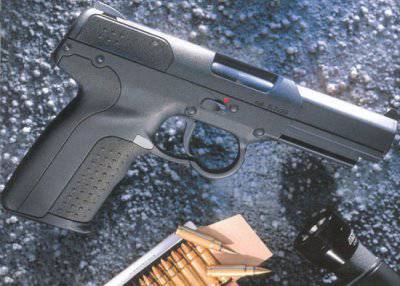 Some time after the release of the army version of the pistol, an option was offered for the police. Despite its external similarity with the previous version of the weapon, this gun is somewhat different in its design and device. First of all, the main difference is the trigger mechanism of ordinary action, that is, before the shot you need to take the bolt back to set the percussion mechanism, it is natural that after each shot it all happens automatically. In order to be able to safely carry a weapon with a cartridge, a non-automatic safety lock is provided in the chamber. Thus, to prepare for the shot, the weapon must either be removed from the safety catch, or else not to use it and not to carry a pistol with a cartridge in the chamber, delaying the bolt if necessary to use a weapon. On the one hand, the fact that the pistol has to be prepared before use is a minus, but most of the pistol models have such a “minus”, so it’s not worth taking into account, but the fact that when you press the trigger you need to put less effort compared to the previous version of the gun, and this is certainly a plus, since this greatly increases the accuracy of shooting, back, comparatively. In all other respects, the weapon was completely analogous to the previous model. This sample had a prefix to the name Tactical.
Some time after the release of the army version of the pistol, an option was offered for the police. Despite its external similarity with the previous version of the weapon, this gun is somewhat different in its design and device. First of all, the main difference is the trigger mechanism of ordinary action, that is, before the shot you need to take the bolt back to set the percussion mechanism, it is natural that after each shot it all happens automatically. In order to be able to safely carry a weapon with a cartridge, a non-automatic safety lock is provided in the chamber. Thus, to prepare for the shot, the weapon must either be removed from the safety catch, or else not to use it and not to carry a pistol with a cartridge in the chamber, delaying the bolt if necessary to use a weapon. On the one hand, the fact that the pistol has to be prepared before use is a minus, but most of the pistol models have such a “minus”, so it’s not worth taking into account, but the fact that when you press the trigger you need to put less effort compared to the previous version of the gun, and this is certainly a plus, since this greatly increases the accuracy of shooting, back, comparatively. In all other respects, the weapon was completely analogous to the previous model. This sample had a prefix to the name Tactical.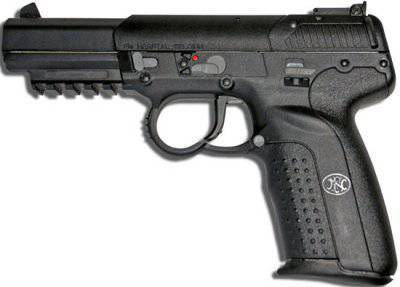 The long production of this gun was not, already in 2004, this model was replaced by a pistol marked IOM (Individual Officers Model). Despite its name, this gun entered the civilian arms market, where people first met it, but they already knew about the ammunition from the civilian version Р90 without the possibility of automatic fire. Externally, this gun can be distinguished by the picatinny-type guide under the barrel on the weapon frame, as well as by the new shape of the casing-bolt. Internally, this gun has not changed in comparison with the previous sample. True, the weapon was supplemented by another point that made it safer, namely, an automatic store fuse. Such an addition is necessary primarily because of the fact that the owner pulls the magazine out of a pistol and believes that after this the weapon is completely safe is not uncommon. As a result, the cartridge remains in the pistol's chamber, and despite the lack of a magazine, the pistol is completely ready for shooting, and this is actually the cause of frequent accidents with pistols, and not only with them. With the Five-seveN IOM pistol, this situation is excluded, since a shot without an inserted magazine is impossible. But even these weapons were not produced for long, and soon the company introduced the next version of the gun, this time the final one.
The long production of this gun was not, already in 2004, this model was replaced by a pistol marked IOM (Individual Officers Model). Despite its name, this gun entered the civilian arms market, where people first met it, but they already knew about the ammunition from the civilian version Р90 without the possibility of automatic fire. Externally, this gun can be distinguished by the picatinny-type guide under the barrel on the weapon frame, as well as by the new shape of the casing-bolt. Internally, this gun has not changed in comparison with the previous sample. True, the weapon was supplemented by another point that made it safer, namely, an automatic store fuse. Such an addition is necessary primarily because of the fact that the owner pulls the magazine out of a pistol and believes that after this the weapon is completely safe is not uncommon. As a result, the cartridge remains in the pistol's chamber, and despite the lack of a magazine, the pistol is completely ready for shooting, and this is actually the cause of frequent accidents with pistols, and not only with them. With the Five-seveN IOM pistol, this situation is excluded, since a shot without an inserted magazine is impossible. But even these weapons were not produced for long, and soon the company introduced the next version of the gun, this time the final one. 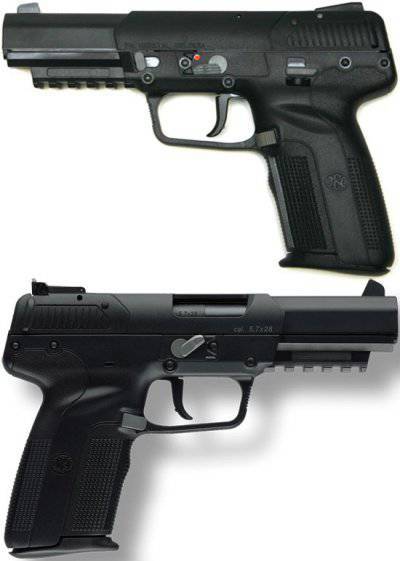 The next version of the weapon was named Five-seveN USG (United States Government), after this version of the weapon went into mass production, other models stopped producing and at the moment this gun is the only mass-produced version of the weapon. Externally, the gun is very easy to find out and distinguish from other previous options. The thing is that in this gun the safety clip is no longer of a complex shape, but a simple, large, straight line, which turned out to be much more convenient than the previous versions. In general, as it seems to me, the previous versions of safety clips were made only for the weapon to be recognizable, but when it had already gained some distribution, they decided to return to the “classics”. Sights were also changed. At first, the gun sights were adjustable, then options with unregulated ones appeared, and after all, it was possible to find both versions of aiming devices in the weapon set, and it was easy to replace them independently, since they were removable. At the moment, there are various options for the execution of this gun, while the diversity even touches the texture of the handle of the weapon, which, in my opinion, is an obvious overkill. Even the lining on the casing-shutter, which are made for more comfortable retention can have both notches, and just bulges, while they are removable and the shooter can choose what he likes more. The trigger mechanism of the pistol, as well as in previous models except the first single action.
The next version of the weapon was named Five-seveN USG (United States Government), after this version of the weapon went into mass production, other models stopped producing and at the moment this gun is the only mass-produced version of the weapon. Externally, the gun is very easy to find out and distinguish from other previous options. The thing is that in this gun the safety clip is no longer of a complex shape, but a simple, large, straight line, which turned out to be much more convenient than the previous versions. In general, as it seems to me, the previous versions of safety clips were made only for the weapon to be recognizable, but when it had already gained some distribution, they decided to return to the “classics”. Sights were also changed. At first, the gun sights were adjustable, then options with unregulated ones appeared, and after all, it was possible to find both versions of aiming devices in the weapon set, and it was easy to replace them independently, since they were removable. At the moment, there are various options for the execution of this gun, while the diversity even touches the texture of the handle of the weapon, which, in my opinion, is an obvious overkill. Even the lining on the casing-shutter, which are made for more comfortable retention can have both notches, and just bulges, while they are removable and the shooter can choose what he likes more. The trigger mechanism of the pistol, as well as in previous models except the first single action.As you can see in all versions of weapons, the location of the controls is the same. So in all but the first version of the gun, there are very small fuse levers that are duplicated on both sides of the weapon. These switches are located above the trigger of the gun, which requires a certain habit, since it is now most convenient to switch them with the index finger of the holding hand. This, according to the designers, reduces the time to prepare for the first shot. To disassemble the weapon, it is enough to pull the bolt all the way back, lock it and squeeze the gun barrel lock, after which the shutter guard is smoothly pulled forward while removing the pistol, and the barrel itself with the return spring entwined around it is separated from the weapon frame. It’s interesting to everyone that the return spring itself is, firstly, entwined around the barrel, and secondly, the return spring is fixed and cannot fly off the barrel of the weapon and get lost, which is a plus when servicing in the field, when everything is done literally sense on the knee. A remarkable point is that the company’s specialists prohibit the further disassembly of weapons, and this is something you can think about. Or the gun is not as simple and thought out as it seems, or too many people have hands that grow out of the wrong place, because a qualified specialist should completely disassemble them, as required by the company. The only thing that I did not understand is whether the guarantee on the weapon is not lost if it is disassembled and assembled completely.
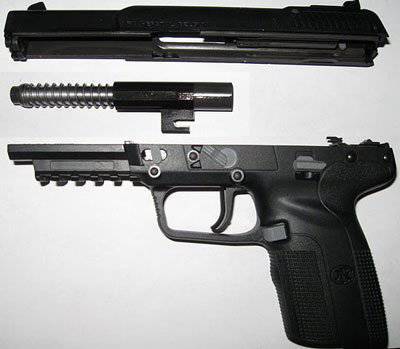 And now the most important thing. Five-seveN pistols are built according to a semi-free-bolt scheme, as the designers managed to accomplish this nobody knows ... Just kidding, this time everything is just like a shovel. Just look at the window to eject the spent cartridges and estimate the thickness of the housing-bolt, the weight of which is greater than the weight of the remaining components of the weapon. So there is a rigid return spring, a heavy shutter, a connection between the barrel of the housing and the shutter, and you can shoot with 5,7x28 cartridges. According to the logic, the large-weight shutter casing had a significant impact on the accuracy of the fire, but here the designers also thought of everything. The barrel of the weapon is underestimated, because the recoil vector when firing is lower than that of other pistols, just as important is that the shutter-casing moves along the inner guides of the frame, which makes it possible to extend the service life of the weapon, since with this arrangement of parts, the “unburdening” during operation is lower that back affects shooting accuracy. By the way, this is confirmed by the fact that the manufacturer guarantees more than 20 thousands of gun shots with proper care and maintenance, apparently serviced by specialists, who can make a complete disassembly.
And now the most important thing. Five-seveN pistols are built according to a semi-free-bolt scheme, as the designers managed to accomplish this nobody knows ... Just kidding, this time everything is just like a shovel. Just look at the window to eject the spent cartridges and estimate the thickness of the housing-bolt, the weight of which is greater than the weight of the remaining components of the weapon. So there is a rigid return spring, a heavy shutter, a connection between the barrel of the housing and the shutter, and you can shoot with 5,7x28 cartridges. According to the logic, the large-weight shutter casing had a significant impact on the accuracy of the fire, but here the designers also thought of everything. The barrel of the weapon is underestimated, because the recoil vector when firing is lower than that of other pistols, just as important is that the shutter-casing moves along the inner guides of the frame, which makes it possible to extend the service life of the weapon, since with this arrangement of parts, the “unburdening” during operation is lower that back affects shooting accuracy. By the way, this is confirmed by the fact that the manufacturer guarantees more than 20 thousands of gun shots with proper care and maintenance, apparently serviced by specialists, who can make a complete disassembly.Just like the P90 submachine gun, the Five-seveN pistols leave a double impression. On the one hand, the weapon seems to be quite effective due to ammunition against opponents in the means of individual armor, on the other hand, I personally do not believe in the stopping effect of the bullet of the cartridge 5,7х28. Thus, the weapon is mainly not intended for the civilian market because of its ammunition, since in the civilian market, I think, pistols for ammunition with heavy, albeit slower bullets are more in demand.
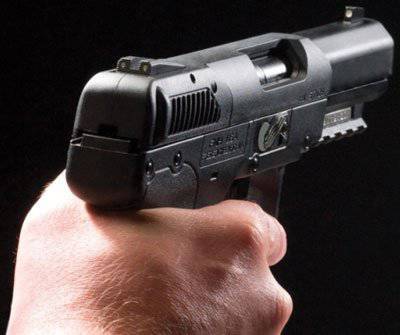 Actually, this is confirmed by the fact that in the civilian market the popularity of this pistol was in the form of a flash - it appeared, tried it, found it unfit. In the military environment, weapons also did not stick, after all, for the ubiquitous distribution and the cartridge itself and weapons were unsuitable for whatever sympathy they felt for it, many accepted the weapon. This weapon is used where there is guaranteed a collision with a protected enemy armor vest, as well as where weapons with an expanded magazine capacity are required. By the way, the gun for the civilian market comes with magazines with a capacity of 10 cartridges, where there is a limit on the amount of ammunition in the store. A standard magazine is a magazine with a capacity of 20 cartridges, a store with an increased capacity fits 30 cartridges, but at the same time it protrudes downwards beyond the pistol grip.
Actually, this is confirmed by the fact that in the civilian market the popularity of this pistol was in the form of a flash - it appeared, tried it, found it unfit. In the military environment, weapons also did not stick, after all, for the ubiquitous distribution and the cartridge itself and weapons were unsuitable for whatever sympathy they felt for it, many accepted the weapon. This weapon is used where there is guaranteed a collision with a protected enemy armor vest, as well as where weapons with an expanded magazine capacity are required. By the way, the gun for the civilian market comes with magazines with a capacity of 10 cartridges, where there is a limit on the amount of ammunition in the store. A standard magazine is a magazine with a capacity of 20 cartridges, a store with an increased capacity fits 30 cartridges, but at the same time it protrudes downwards beyond the pistol grip.Well, in conclusion, the most important thing - tsiferki. The total length of the pistol with the barrel length in 122 millimeters is 208 millimeters. The height of the weapon with the standard magazine is equal to 145 millimeters. The width of the gun is considerable - 36 millimeters. The weapon without ammunition weighs about 600 grams, and the weight can vary within narrow limits due to the fact that the handle of the gun can be equipped with various removable rear parts. The effective distance of using the weapon to 50 meters, although the target can be confidently hit and at a distance of 150 meters, how far the bullet flies, saving the lethal energy, unfortunately, the data diverge, therefore it is better to keep silent about them.
In general, such a weapon was created as a company for the P90 submachine gun.
Information